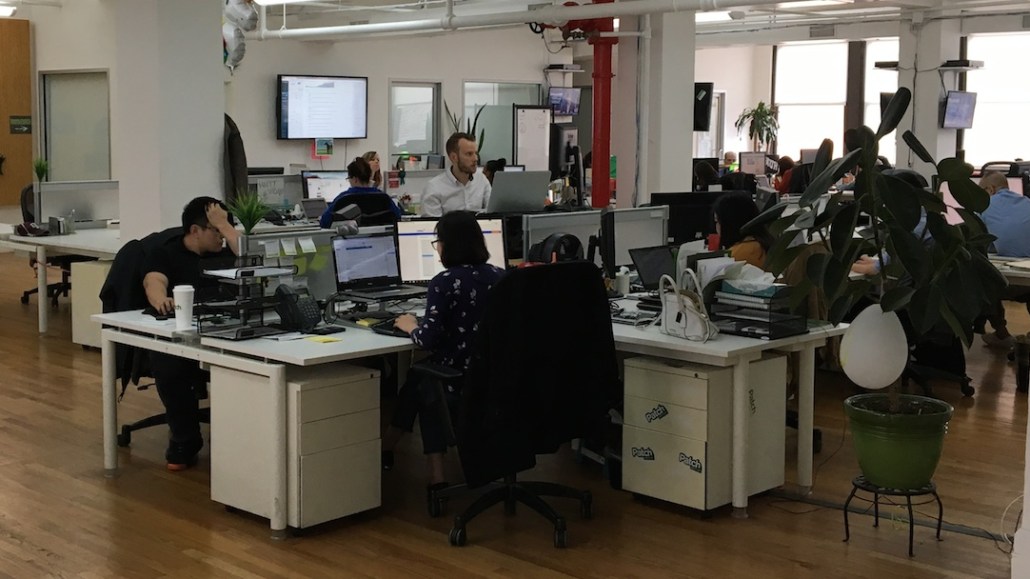
Patch used to be a cautionary tale of the perils of solving the thorny problem of doing local news in digital media.
But AOL’s onetime struggling experiment in hyperlocal news has returned to its feet after the portal sold it in 2014. Now profitable, it wants to help other local news outlets fight for survival.
First, the background: At its height in 2014, Patch employed 540 people for 900 local news sites in 23 states that doled out a diet of local police and fire, government, human interest and events news, but lost millions of dollars. Today, under investment firm Hale Global (although AOL still has a sizable stake), it has scaled back to 130 staffers (along with about 30 freelancers) for 1,030 Patches. But most important, Patch has figured out a profitable model. It got rid of unprofitable advertisers by requiring them to spend at least $4,000 and set up a self-serve platform for smaller advertisers and people who wanted to pay to promote local events and other announcements. The New York-based company was profitable for all of 2016 and for each month in the first quarter of 2017. No, Patch is not about to threaten Google and Facebook, but for local news, Patch is approaching the status of an unlikely success story.
Unlike many venture-backed publishers that are chasing scale first, profits second, Patch has taken a conservative approach. Last year, it opened its first site in a while, in Austin, Texas, followed by several others in markets including Houston; Portland, Oregon; Miami; Charlotte, North Carolina; and Phoenix (and reviving dormant sites in New York City). When it was owned by AOL, Patch would blanket a market with local Patch editions, which got it name recognition but wasn’t economically sustainable.
For the new launches, the company is “reversing the adoption model,” starting with one editor per market to establish a beachhead and adding after the audience comes along, said Charles Hale, chairman of Hale Global. “We want to be in the position of getting better every day instead of promising something we can’t fulfill,” said Warren St. John, Patch’s CEO and a former New York Times reporter.
For the next phase, internally called “Operation Sprout,” Patch is setting up local pages for top 125 designated market areas where it doesn’t already have a presence, such as Boise, Idaho, and New Orleans, then bringing in an editor if traffic shows promise. Patch has hired 20 journalists in the past three months to fund this expansion.
Now that it’s found its financial footing, Patch has started to look at how it can strike mutually beneficial alliances with local news outlets, particularly independent local papers that can’t afford the costly infrastructure publishers today need to play in a media landscape dominated by programmatic advertising and social distribution.
“A lot of local publishers don’t have the technology,” St. John said. “There’s a big opportunity to solve local publishers’ scale issues.”
The first stage has been for Patches to distribute links of other local publishers. The trade is that local publisher still gets credit for the pageview, and the local Patch gets more content to run on its site.
For the next stage, in the second half of the year, Patch plans to invite local news outlets to migrate their sites to Patch. The idea is similar to the way Medium has begun hosting publishers on its platform to offer them the advantage of its network effect, although publishers that have done so have had mixed traffic results.
The newspaper industry has been going through a prolonged structural decline, according to the Pew Research Center. There were 1,331 daily papers in 2014, a decline of 126 from 2004, according to Pew, citing Editor & Publisher’s DataBook, and the number of papers reporting losses rose sharply from 2014 to 2015. Digital has grown to compose a quarter of newspaper revenue, but that has more to do with a decline in the share of print revenue than digital’s growth.
St. John said the decline of local papers hit him firsthand when he went on book tours in local communities in 2004 and 2009. “My tour in 2009, there was no book reviewer,” he said.
Patch’s pitch is that local outlets can benefit from its tech backbone and social media skills that hyperlocal news needs in order to scale. By having a single editorial platform, Patch can easily publish content from all 1,030 Patches to Apple News. Patch reached 14 million uniques in March, up 19 percent year over year, according to comScore (Patch’s Google Analytics puts it at 22 million). It’s avoided being overly reliant on any one traffic source: 25 percent of it comes from Facebook (which Patch boasts is entirely organic). Search and email newsletters contribute another 30 percent each. The rest of Patch’s traffic is direct or referral.
Patch’s leaders like playing the underdog, but they’re starting to be more assertive since the ownership change three years ago when even they questioned their own ability to fix hyperlocal.
“Back then, I would have said, ‘I don’t know,’” St. John said. “Now, I would say, I think Patch is playing and will continue to play an important role in hyperlocal journalism. We have a business model that’s made it possible to continue to invest. I think we’re on to something. But we have a long way to go.”
Photo: Patch
More in Media

AI royalties for small and midsize publishers: collective licensing’s next big play
Don’t credit OpenAI’s ChatGPT, credit corporate LLMs – enterprise RAG is what’s creating royalty revenue for publishers.

The Economist licenses its content to enterprise clients’ private LLMs
The Economist is among those to start licensing its content this way – having opened its API to corporate clients with their own data ring-fenced LLMs in August.

Media Briefing: Why some publishers are flipping their position on whether to block AI bots
Some publishers that blocked all AI bots are rethinking their stance, as AI platform traffic raises new monetization and access trade-offs.





